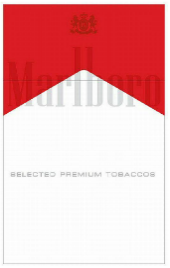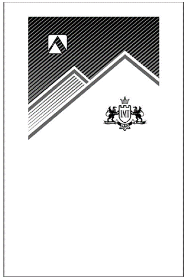

As expected, in its decision of 21 December 2022 (T-44/22), the General Court (GC) upheld the refusal of the packaging design shown above on the right as a trademark for tobacco products in class 34, agreeing with the EUIPO that it would take unfair advantage of the reputation of the Marlboro rooftop mark.
The trademark applicant, International Masis Tabak (IMT) from Armenia, registered the opposed figurative mark as an international registration designating several countries around the world. The mark was granted protection in some jurisdictions but failed in the EU, where it was opposed by the tobacco giant Philip Morris Brands (PMB), the owner of Marlboro, on the grounds of likelihood of confusion and reputation in the Marlboro rooftop mark for cigarettes.
While the opposition was based on seven earlier marks, the EUIPO focused on only one of these, namely, the figurative mark protected in the EU shown above on the left. It concluded that the earlier mark has enhanced distinctiveness through use and a substantial reputation for cigarettes relating to the world element “marlboro” and the figurative element in the shape of a rooftop.
This decision was upheld by the EUIPO Board of Appeal and so IMT took the case to Luxembourg, where it again lost.
Interestingly, the GC emphasised that the degree of similarity for protection of the reputation of a trademark from misappropriation (Art. 8(5) EUTMR) can be lower than for likelihood of confusion (Art. 8(1)(b)) – provided that it is still sufficient for the relevant public to establish a link between them (para. 29).
The GC agreed with the Board of Appeal that the signs are purely figurative as their dominant element was the polygon in the upper part while the verbal elements were so small that they were barely perceptible and therefore did not play a role. The polygons were considered similar – despite their differences (for example that the opposed sign had two peaks, neither in the centre, while the Marlboro rooftop design has a single peak and is fully symmetrical). The resulting visual similarity was decisive as an aural or conceptual comparison was not possible.
IMT argued that its sign would be associated with Mount Ararat or at least some mountain, but the GC considered that it would be seen just an abstract triangular geometric shape, at least by the majority of the relevant public. That the description of the opposed sign said that the “mark features two triangular-shaped lines (…), which almost resemble the peaks of a mountain range” did not matter.
Further, the GC emphasised that the visual impression conveyed by the signs was most important as tobacco products were often inspected visually during the purchase situation. This conclusion is odd given that, as mentioned, it had previously held that a phonetic comparison could not be made.
Having concluded that the marks were similar, at least to a low degree, the GC confirmed that the relevant public would make a link between the marks, also bearing in mind that the goods were identical and that the reputation of the Marlboro rooftop design had been shown to be substantial.
PMB could also convince the Court that the use by IMT of the contested sign would allow it to ride on its coat tails. PMB proved not only a substantial reputation but also that it used the polygon in different colours and for different ranges of Marlboro cigarettes. Consumers would therefore easily be misled into believing that the contested mark was merely a new variant of these.
This decision as such came as no surprise given that PMB had been successful in both prior EUIPO instances. It is, however, interesting with a view to the strength given to the core branding element in the earlier mark and its non-identical replica in the contested mark, and the GC’s clear comments on the (lower) degree of similarity required for protection from misappropriation vs. likelihood of confusion in para. 29 of the decision.
In any event, it will be interesting to see if tobacco marks manage to maintain their consumer appeal and reputation, despite the (almost) inability to advertise, and ever increasing brand restrictions for tobacco.
_____________________________
To make sure you do not miss out on regular updates from the Kluwer Trademark Blog, please subscribe here.
Kluwer IP Law
The 2022 Future Ready Lawyer survey showed that 79% of lawyers think that the importance of legal technology will increase for next year. With Kluwer IP Law you can navigate the increasingly global practice of IP law with specialized, local and cross-border information and tools from every preferred location. Are you, as an IP professional, ready for the future?
Learn how Kluwer IP Law can support you.



The “rooftop” cigarette packaging controversy refers to the debate over whether cigarette companies should be allowed to use colorful and distinctive branding on their packaging, including on the top of the cigarette packs, which is sometimes referred to as the “rooftop” branding. Many health advocates argue that such branding makes cigarettes more appealing, especially to young people, and that plain packaging would reduce smoking rates.
It is unclear which party you are referring to as PMB, but if you are referring to a company or organization that supports plain packaging, it is possible that they have won a final round in the battle over rooftop packaging. However, I cannot confirm this without more information.